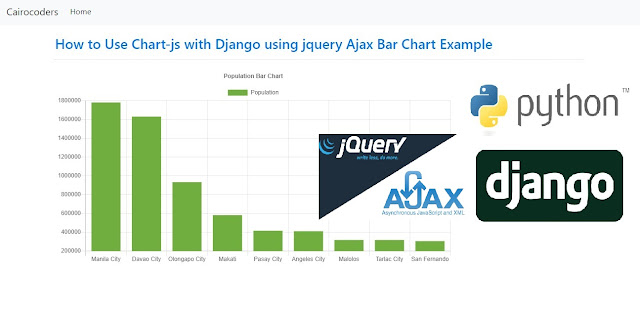
How to Use Chart-js with Django using jquery Ajax Bar Chart Example
In this tutorial we are going to a Bar chart using jquery ajax based on data extracted from our models.
You can download it from Chart.js official website and use it locally, or you can use it from a CDN using the URL above.
https://www.chartjs.org/
npm CDN Files https://www.jsdelivr.com/package/npm/chart.js?path=dist
view.py
#view.py
from django.shortcuts import render
from django.db.models import Sum
from django.http import JsonResponse
from myapp.models import City
def home(request):
return render(request, 'home.html')
def population_chart(request):
labels = []
data = []
queryset = City.objects.values('name').annotate(population=Sum('population')).order_by('-population')
for entry in queryset:
labels.append(entry['name'])
data.append(entry['population'])
return JsonResponse(data={
'labels': labels,
'data': data,
})
urls.py
#urls.py
from django.contrib import admin
from myapp import views
from django.conf.urls import url
from django.urls import path, include
urlpatterns = [
path('admin/', admin.site.urls),
path('', views.home, name='home'),
path('population-chart/', views.population_chart, name='population-chart'),
]
models.py
#models.py
from django.db import models
class City(models.Model):
name = models.CharField(max_length=30)
population = models.PositiveIntegerField()
def __str__(self):
return self.name
class Meta:
db_table = 'myapp_city'
templates/home.html
//templates/home.html
{% extends 'base.html' %}
{% block content %}
<div id="container" style="width: 75%;">
<canvas id="population-chart" data-url="{% url 'population-chart' %}"></canvas>
</div>
<script src="https://code.jquery.com/jquery-3.4.1.min.js"></script>
<script src="https://cdn.jsdelivr.net/npm/chart.js@2.9.3/dist/Chart.min.js"></script>
<script>
$(function () {
var $populationChart = $("#population-chart");
$.ajax({
url: $populationChart.data("url"),
success: function (data) {
var ctx = $populationChart[0].getContext("2d");
new Chart(ctx, {
type: 'bar',
data: {
labels: data.labels,
datasets: [{
label: 'Population',
backgroundColor: '#6fae3f',
data: data.data
}]
},
options: {
responsive: true,
legend: {
position: 'top',
},
title: {
display: true,
text: 'Population Bar Chart'
}
}
});
}
});
});
</script>
{% endblock %}
templates/base.html
//templates/base.html
<!DOCTYPE html>
<html lang="en">
<head>
<meta charset="UTF-8" name="viewport" content="width=device-width, initial-scale=1"/>
<title>{% block title %}Django Highcharts {% endblock %}</title>
<link rel="stylesheet" href="https://stackpath.bootstrapcdn.com/bootstrap/4.5.0/css/bootstrap.min.css" integrity="sha384-9aIt2nRpC12Uk9gS9baDl411NQApFmC26EwAOH8WgZl5MYYxFfc+NcPb1dKGj7Sk" crossorigin="anonymous">
</head>
<body>
<nav class="navbar navbar-expand-lg navbar-light bg-light">
<a class="navbar-brand" href="#">Cairocoders</a>
<button class="navbar-toggler" type="button" data-toggle="collapse" data-target="#navbarNavAltMarkup" aria-controls="navbarNavAltMarkup" aria-expanded="false" aria-label="Toggle navigation">
<span class="navbar-toggler-icon"></span>
</button>
<div class="collapse navbar-collapse" id="navbarNavAltMarkup">
<div class="navbar-nav">
<a class="nav-item nav-link active" href="">Home</a>
</div>
</div>
</nav>
<div class="container" style="padding:20px;">
<div class="col-md-12 well">
<h3 class="text-primary">How to Use Chart-js with Django using jquery Ajax Bar Chart Example</h3>
<hr style="border-top:1px dotted #ccc;"/>
{% block content %} {% endblock %}
</div>
</div>
</body>
</html>










